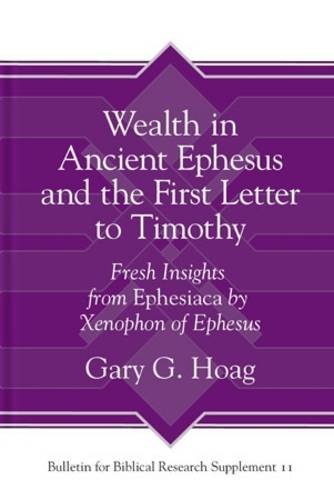Q2.BEN: From the outset of your study, you seem concerned to take the old Dibelius and Conzelmann claim about the supposed ‘bourgeois ethics’ of the Pastoral Epistles to task. They seem to have assumed the ethics in the Pastorals were at odds with the eschatological ethics of other parts of the NT, and reflected a capitulation to or accommodation with the cultural norms of the day. By contrast, you suggest that the Pastorals reflect something of a counter-cultural ethic. In what ways would you say the Pastorals reflect a counter-cultural ethic?
A2.GARY: My research, at least in part, takes Dibelius and Conzelmann claims to task because their conclusions drawn from limited ancient sources resulted in inadequate conclusions. For example, because the author of 1 Tim used language not found in the Pauline homologoumena but that appears among the writings of the Hellenistic moralists, in Ephesian inscriptions, and other sources, they argued that the theology and ethics of 1 Tim reflected accommodation with the cultural norms of the day. In so doing, they stuck a proverbial christliche Bürgerlichkeit, or “Christian good citizenship,” flag in the ground of 1 Tim scholarship.
Philip Towner (1989) addressed the claims of Dibelius and Conzelmann head on by showing readers that any perceived accommodation to cultural norms can be explained as missional living without diminished eschatological enthusiasm. Reggie Kidd (1990) put forth a more middle position suggesting that sometimes the teachings on wealth in 1 Tim can be read as consistent with the radical theology and ethics of the Gospels and sometimes inconsistent. In his words, they have both bürgerlich and anti-bürgerlich traits.
I appreciated the angle that Towner had taken and was not convinced by Kidd’s case. As unresolved interpretive issues orbited around not the use of rare terms and themes but the function and meaning of rare terms and themes in passages with wealth in view, I chose to look for clues for reading them from the social and cultural context to which 1 Tim was directed: Ephesus (cf. 1 Tim 1:3). In plain terms, I wanted to locate a Sitz im Leben, “setting in life,” for Ephesians with wealth, and see what message the texts of 1 Tim may be saying to them in their setting. This approach was inspired by a four-hour visit with Abraham Malherbe. We read through 1 Tim in Greek and about every 2-3 verses he would comment on how a term or theme appeared in other ancient sources. I was mesmerized. He inspired me to explore epigraphic, numismatic, archaeological, literary, and other evidence with an Ephesian provenance.
At this point, I will reply with regard to how I believe 1 Tim reflects a counter-cultural ethic by citing a number of examples. In 1:1, the author of 1 Tim refers to “God our Savior and Christ Jesus our Hope”. That’s counter-cultural opening statement! Names that numerous ancient sources affix to the emperor and the goddess are attached instead to God and Jesus. In Ephesian inscriptions, Julius Caesar is both “God” and “Savior” (IvE 251). On coins, the image of Artemis appears with the term “Savior” and writers like Achilles Tatius report that her temple as an ultimate place of “hope” in the ancient world (Leucippe and Clitophon 7–8).
The letter then announces counter-cultural intent. Timothy is commanded to remain in Ephesus to refute a different doctrine (a heresy) that is contrary to the economy of God by faith (1:3-4). Rather than rehash my explanation of the identity of his opponents dedicated to “myths and endless genealogies which promote speculations” (BBRS 11: 163, 172, 187), in short, what comes into view especially in inscription evidence (IvE 27 among others and corroborated by Ephesiaca) is that the prominent citizens who can trace their Ionian roots back to the foundation of the city desire to preserve the sacred identity of the city, namely, the Artemis myth. Against this formidable foe whose laws (1:7) were expected to be honored by all, Timothy must wage the good warfare (1:18) and teach people how to live in God’s house.
As you move into 1 Tim 2, in ancient Ephesus it would have been scandalous for the author of 1
Tim to say that “there is one God and one mediator between God and mankind, the man Christ Jesus” (2:5). For example, Strabo reports that Aristarcha visited the Artemisium to receive an oracle (Geography 4.1.4) and likewise in Ephesiaca, in a time of crisis the parents of both Anthia and Habrocomes seek an oracle. My point is simply to say the evidence reveals the prevailing cultural norm was to see various gods as mediators. This is a counter-cultural statement.













